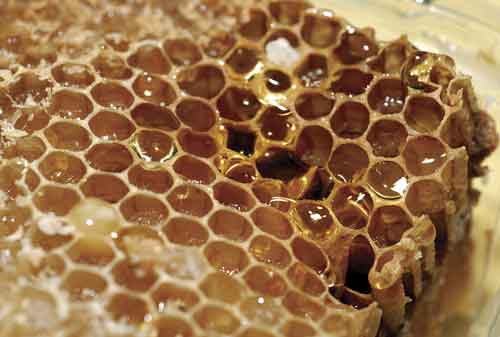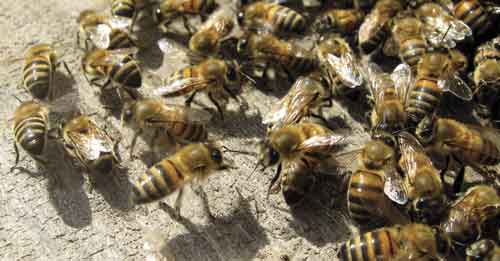A Spoonful of Honey
2nd in a series by Judy Cohen
The natural healing properties of honey cover a wide range of ailments, and more uses are still being discovered.
Doña Gavi’s tienda, located on 3a avenida behind the cathedral in La Antigua Guatemala, carries all-natural products, including several types of honey. Her favorite is gravilea, which she buys from nearby farms. I learned some of the local folklore on bees and honey from our interview.
“The floripondia flowers are planted to grow up the fences surrounding a coffee finca and protect it from harm,” she told me.
“Do you mean physical harm?” I asked.
“No, no, spiritual. It’s an old Indian belief. You see, the pink and white floripondia and the yellow flowers of the gravilea trees, which shade the coffee plants, have pollens that induce sleep. When the wind blows, these pollens are spread across the Panchoy Valley and make it tranquil.”
True or not, it’s a lovely story. What is a fact is that honey has made a medical comeback: Its properties have been proven to aid in the healing of deep wounds, diabetic ulcers, open sores, gangrene and second- and third-degree burns where antibiotics have been less effective. Honey is also effective in treating symptoms of bronchitis and asthma.
Germs cannot live in honey because of its antibiotic, antiviral, anti-inflammatory, anticarcinogenic, antifungal and other “anti” properties. Occasionally, a strain of botulism will survive; that is why there are warnings not to feed honey to babies under a year old.
Honey, unlike sugar, is not full of empty calories. Besides the enzymes added by bees to the flower nectar, it contains trace minerals, vitamins A, B, C, D and K plus proteins and hydrogen peroxide.
One doctor used honey-gauze bandages on children injured in the Iraq war. The parents liked them because they were natural products and didn’t have to be changed as often as other bandages. Second- and third-degree burns healed without scars. The doctor said he unquestionably would use this method on any one of his five children as a first choice for those types of injuries.
In 2007, the U.S. Food and Drug Administration approved the use of honey-gauze bandages made by a New Jersey company named Derma Sciences, Inc. Medihoney bandages are sold in North and South America by Convita L.P. of New Zealand; it also controls the supply of New Zealand manuka honey.
All honey has benefits ranging from mild to strong. But only two honeys have been found so far with enough antibacterial and antifungal strength to heal seriously infected wounds, diabetic ulcers, chronic sores and second- and third-degree burns. They belong to the genus Leptospermum (myrtle family).
The flowering plants that these honeys come from are the manuka tree (or jelly bush) in New Zealand and the golden tea tree in Australia.
Seventy-nine varieties of honey were catalogued in these two countries. Only these two tested active (strong) enough to kill or inhibit serious and chronic external skin infections. But, they are not miracle cures. For example, they don’t cure infections in the blood.
Activity, or the strength of the two honeys, depends on the area of the country where the bees produced them. Activity ratings run from 10+ to 20+; meaning how fast and well they can heal wounds.
For deep wounds (diabetic ulcers and chronic non-healing sores) an activity level of 16+ to 18+ is recommended. Higher ratings can cause burning sensations. But there are no serious adverse side effects observed in any of the clinical trials of honey bandages.
Interesting fact: Bee pollen has more protein per pound than meat, and if stranded on a desert island, a person could live on bee pollen and water.
In Guatemala, where arable land is so scarce, food so sparse in some areas and diabetes rampant, surely we can find many uses for this honey and test more of our own varieties.


HI
I just read your article on new Leptospermum plants being planted in Guatamala for the honey for its properties.
Can you please tell me more about that? i would like to know which species and which cultivars you are using and if the plants are producing flowers for honey yet.
Thanks a lot
Jenny Aitken
Jenny,
No, I’m afraid at this point planting the Leptospermum “jelly bushes” in Guatemala, is only a pipe dream. I’m sure I didn’t say this was happening.
Both Australia and New Zealand, I’m sure, have very strict laws about exporting plants, particularly valuable ones which at this time, are only found in their countries.
That is not to say I wish we had them here. They evidently grow wild, bees fly everywhere and pollinate crops. Honey is not like pineapple, sugar or coffee. Much land is not necessary. I thought honey production would be a perfect occupation for the small farmers who make a marginal living now.
How to do it, I don’t know. In the U.S., I emailed my doctor about medicinal honey. He works at Kaiser Medical, a very large HMO. They haven’t heard of it, or if they have, don’t use it. But doctors did in Iraq according to my research.
There are only two species of the myrtle family which produce honey strong enough to cure bad skin sores. This is out of 79 varieties found in the two countries, Aust. and N.Z. And its strength depends on where in the country these species are grown.
Wish I could help you more. Let me know if you discover anything that might push us forward.
Yours truly,
Judy Cohen